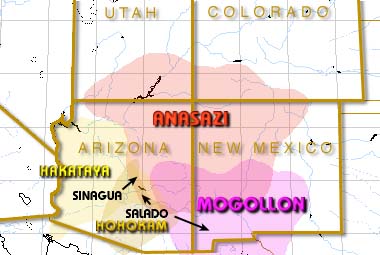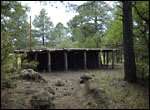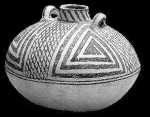Prehistoric Native Peoples of Northern Arizona
 The area around the San Francisco Peaks in Northern Arizona was a place where several ancient cultures met and interacted. The Sinagua culture ranged from Sunset Crater and Wupatki northeast of Flagstaff, to Walnut Canyon east of Flagstaff, south to Montezuma's Castle in the Verde Valley. Beneath the cinders of Sunset Crater, ruins were located near earlier volcanic activity, showing that they understood the value of volcanic soils for farming. The Sinagua used mud and stone masonry construction for pithouses and small surface graneries. Eventually, they used the surface structures for living. They probably traded obsidian for projectile points, pinyon nuts, and baskets. People were often buried in a room, thus making the ancient pueblo villages "living monuments to our ancestral people."
The area around the San Francisco Peaks in Northern Arizona was a place where several ancient cultures met and interacted. The Sinagua culture ranged from Sunset Crater and Wupatki northeast of Flagstaff, to Walnut Canyon east of Flagstaff, south to Montezuma's Castle in the Verde Valley. Beneath the cinders of Sunset Crater, ruins were located near earlier volcanic activity, showing that they understood the value of volcanic soils for farming. The Sinagua used mud and stone masonry construction for pithouses and small surface graneries. Eventually, they used the surface structures for living. They probably traded obsidian for projectile points, pinyon nuts, and baskets. People were often buried in a room, thus making the ancient pueblo villages "living monuments to our ancestral people."
 The Cohonina (western branch of the Patayan culture) occurred west and northwest of the Peaks. They were a farming and hunting group. Their dwellings were probably shade-type surface shelters. Their land was a source of raw materials used in ceremonial activities and for ornaments such as turquoise from western Arizona, red ochre for making paint, and abalone shell from the California coast. They apparently made few items for trade. Since they cremated their dead, there is little evidence of the way they lived. The Cohonina (western branch of the Patayan culture) occurred west and northwest of the Peaks. They were a farming and hunting group. Their dwellings were probably shade-type surface shelters. Their land was a source of raw materials used in ceremonial activities and for ornaments such as turquoise from western Arizona, red ochre for making paint, and abalone shell from the California coast. They apparently made few items for trade. Since they cremated their dead, there is little evidence of the way they lived.
 The Hohokam were south of the Peaks area and were renowned for their irrigation farming in the desert. They traded many items imported from the south, some from the Indians of Mexico: copper bells, finely worked shell, Macaws. Each of their towns contained a ball court, as does Wupatki. It's possible that the ball court and its activities served as a focal point for ceremonies and rituals that facilitated the exchange of goods and ideas among the cultures that met there. The Hohokam were south of the Peaks area and were renowned for their irrigation farming in the desert. They traded many items imported from the south, some from the Indians of Mexico: copper bells, finely worked shell, Macaws. Each of their towns contained a ball court, as does Wupatki. It's possible that the ball court and its activities served as a focal point for ceremonies and rituals that facilitated the exchange of goods and ideas among the cultures that met there.
 The Anasazi occurred northeast of the Sinagua, from the Peaks area to Four Corners. These pueblo people built masonry houses and subterranean men's club and ceremonial rooms (kivas). Their skillful pottery was decorated in gray and black and white, and found throughout the south and west. Their pots had wide appeal and were widely traded. The dead were buried in a flexed position. The Anasazi occurred northeast of the Sinagua, from the Peaks area to Four Corners. These pueblo people built masonry houses and subterranean men's club and ceremonial rooms (kivas). Their skillful pottery was decorated in gray and black and white, and found throughout the south and west. Their pots had wide appeal and were widely traded. The dead were buried in a flexed position.
|

 The area around the San Francisco Peaks in Northern Arizona was a place where several ancient cultures met and interacted. The Sinagua culture ranged from Sunset Crater and Wupatki northeast of Flagstaff, to Walnut Canyon east of Flagstaff, south to Montezuma's Castle in the Verde Valley. Beneath the cinders of Sunset Crater, ruins were located near earlier volcanic activity, showing that they understood the value of volcanic soils for farming. The Sinagua used mud and stone masonry construction for pithouses and small surface graneries. Eventually, they used the surface structures for living. They probably traded obsidian for projectile points, pinyon nuts, and baskets. People were often buried in a room, thus making the ancient pueblo villages "living monuments to our ancestral people."
The area around the San Francisco Peaks in Northern Arizona was a place where several ancient cultures met and interacted. The Sinagua culture ranged from Sunset Crater and Wupatki northeast of Flagstaff, to Walnut Canyon east of Flagstaff, south to Montezuma's Castle in the Verde Valley. Beneath the cinders of Sunset Crater, ruins were located near earlier volcanic activity, showing that they understood the value of volcanic soils for farming. The Sinagua used mud and stone masonry construction for pithouses and small surface graneries. Eventually, they used the surface structures for living. They probably traded obsidian for projectile points, pinyon nuts, and baskets. People were often buried in a room, thus making the ancient pueblo villages "living monuments to our ancestral people."
 The
The 
